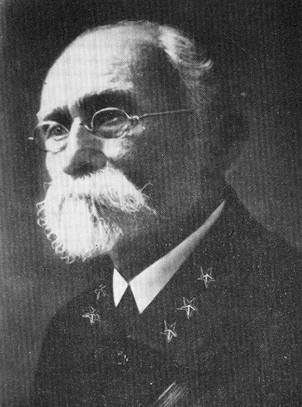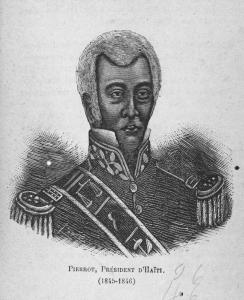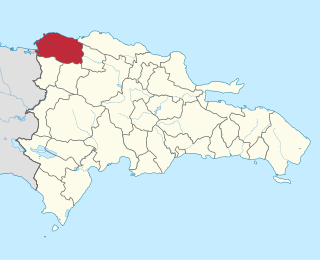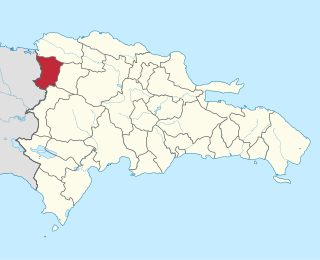
The Dominican Republic is a country located on the island of Hispaniola in the Greater Antilles archipelago of the Caribbean region. It occupies the eastern five-eighths of the island, which it shares with Haiti, making Hispaniola one of only two Caribbean islands, along with Saint Martin, that is shared by two sovereign states. The Dominican Republic is the second-largest nation in the Antilles by area at 48,671 square kilometers (18,792 sq mi), and third-largest by population, with approximately 10.7 million people, down from 10.8 million in 2020, of whom approximately 3.3 million live in the metropolitan area of Santo Domingo, the capital city. The official language of the country is Spanish.

Máximo Gómez y Báez was a Dominican Generalissimo in Cuba's War of Independence (1895–1898). He was known for his controversial scorched-earth policy, which entailed dynamiting passenger trains and torching the Spanish loyalists' property and sugar plantations—including many owned by Americans. He greatly increased the efficacy of the attacks by torturing and killing not only Spanish soldiers, but also Spanish sympathizers and especially Cubans loyal to Spain. By the time the Spanish–American War broke out in April 1898, the rebellion was virtually defeated in most of Western Cuba, with only a few operating pockets in the center and the east. He refused to join forces with the Spanish in fighting off the United States, and he retired to the Quinta de los Molinos, a luxury villa outside of Havana after the war's end formerly used by captains generals as summer residence.

The Dominican War of Independence made the Dominican Republic a sovereign state on February 27, 1844. Before the war, the island of Hispaniola had been united for 22 years when the newly independent nation, previously known as the Captaincy General of Santo Domingo, was unified with the Republic of Haiti in 1822. The criollo class within the country overthrew the Spanish crown in 1821 before unifying with Haiti a year later.

Prince Jean-Louis Michel Paul Pierrot, Baron of Haïti was a career officer general in the Haitian Army who also served as President of Haiti from 16 April 1845 to 1 March 1846.

Charles Rivière-Hérard also known as Charles Hérard aîné was an officer in the Haitian Army under Alexandre Pétion during his struggles against Henri Christophe. He was declared President of Haiti on 4 April 1843. He was forced from office by revolutionaries on 3 May 1844.
The Battle of Azua was the first major battle of the Dominican War of Independence and was fought on the 19 March 1844, at Azua de Compostela, Azua Province. A force of some 2,200 Dominican troops, a portion of the Army of the South, led by General Pedro Santana and General Antonio Duvergé defeated an outnumbering force of 10,000 troops of the Haitian Army led by General Souffrand.
The Battle of Santiago was the second major battle of the Dominican War of Independence and was fought on the 30 March 1844, at Santiago de los Caballeros, Santiago Province. Although outnumbered, Dominican troops, part of the Army of The North and led by General José María Imbert, defeated Haitian Army troops led by General Jean-Louis Pierrot.

The Battle of Las Carreras was a major battle during the years after the Dominican War of Independence and was fought on the 21–22 April 1849, nearby Baní, Peravia Province. A force of 800 Dominican troops, a portion of the Army of the South, led by General Pedro Santana, defeated an outnumbering force of 10,000 troops of the Haitian Army led by Faustin Soulouque.

The Battle of El Número was a major battle during the years after the Dominican War of Independence and was fought on the 17 April 1849, nearby Azua de Compostela, Azua Province. A force of 300 Dominican troops, a portion of the Army of the South, led by General Francisco Domínguez and General Antonio Duvergé encountered an outnumbering force of 10,000 troops of the Haitian Army led by General Jean Francois Jeannot.

The Battle of Beler was one of the major battles of the Dominican War of Independence and was fought on the 27 November 1845 at the Beler savanna, Monte Cristi Province. A force of Dominican troops, a portion of the Army of the North, led by General Francisco Antonio Salcedo, defeated a force of the Haitian Army led by General Jean-Louis Pierrot, while 3 Dominican schooners led by Admiral Juan Bautista Cambiaso, blockaded the port of Cap-Haïtien to prevent sea reinforcements of the near sited land battle.

The Battle of Estrelleta was a major battle of the Dominican War of Independence and was fought on September 17, 1845, at the site of Estrelleta, near Las Matas de Farfán, San Juan Province. A force of Dominican troops, a portion of the Army of the South, led by General Antonio Duvergé, defeated an outnumbering force of the Haitian Army led by General Jean-Louis Pierrot.
The Battle of El Memiso was the third major battle of the Dominican War of Independence and was fought on the 13 April 1844, at El Memiso, Azua Province. A force of Dominican troops, a portion of the Army of the South, led by General Antonio Duvergé, defeated an outnumbering force of the Haitian Army led by Col. Pierre Paul.

The Haitian occupation of Santo Domingo was the annexation and merger of then-independent Republic of Spanish Haiti into the Republic of Haiti, that lasted twenty-two years, from February 9, 1822 to February 27, 1844. While many Haitians view the invasion and occupation of Spanish Santo Domingo as a "unification" of the island designed to protect their country from re-enslavement via the Spanish side, Dominicans consider it as a forced military invasion and occupation. The Haitian occupation's suppression of Dominican culture, forceful redistribution of Dominican wealth, and strict policies based on labor led to growing resentment that culminated in a Dominican movement for national independence, which was attained in February 1844.

The Second Empire of Haiti, officially known as the Empire of Haiti, was a state which existed from 1849 to 1859. It was established by the then-President, former Lieutenant General and Supreme Commander of the Presidential Guards under President Riché, Faustin Soulouque, who, inspired by Napoleon, declared himself Emperor Faustin I on 26 August 1849 at the Cathedral of Our Lady of the Assumption in Port-au-Prince.

Ulises Hilarión Heureaux Leibert nicknamed Lilís, was president of the Dominican Republic from September 1, 1882 to September 1, 1884, from January 6, 1887 to February 27, 1889 and again from April 30, 1889 maintaining power between his terms until his assassination by Ramón Cáceres.

Pablo Alí was a chief military commander of Haitian origin, who was in charge of the so-called Battalion 31 or Batallon de Morenos, freed slaves which joined the ranks of the Dominican army. Alí directed the battalion to participate in the Italian rebellion of 1810, during the government of Sánchez Ramírez. He was said to have been "most prominent, achieving great military distinction in Santo Domingo".
The Massif du Nord is the longest mountain range of Haiti.

The Battle of Sabana Larga was a major battle during the years after the Dominican War of Independence. It was fought on 24 January 1856 in Sabana Larga, Dajabón. A force of 8,000 Dominican troops of the northern army, led by General Juan Luis Franco Bidó, defeated a numerically larger force of 22,000 troops of the Haitian army under Emperor Faustin I. Another part of the Haitian army was entrenched in Jácuba near Puerto Plata, but were defeated by Florentino and General Peter Lucas Peña.

The Battle of Santomé was a major battle during the years after the Dominican War of Independence and was fought on the 22 December 1855, in the province of San Juan. A detachment of Dominican troops forming part of the Army of the South, led by General José María Cabral, defeated an outnumbering force of the Haitian Army led by Antoine Pierrot. The Haitians met defeat on the same day at Cambronal.
The Battle of Fort Cachimán was a battle of the Dominican War of Independence and was fought on the 6 December 1844 at the border close to Elías Piña. A force of Dominican troops, a portion of the Army of the South, led by General Antonio Duvergé, defeated an outnumbering force of the Haitian Army led by General Seraphin and captured the Haitian fort.















